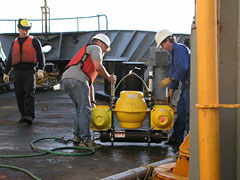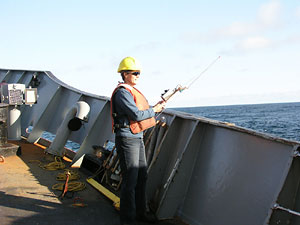

 | |||||||||||
|
|
Journals 2006/2007Miriam Sutton
August 31, 2006 AM Location: The Gully (43° 58' 50.51" N, 58° 58' 59.82" W) I awoke at 5:30AM this morning to assist the seismic team with their last mission: Locate and retrieve three Ocean Bottom Seismometers (OBS) from the seafloor. (See OBS photo below.) The seismometers were deployed to the seafloor in July 2006 and programmed to record underwater sounds through mid-August. The data is used to track the movement of whales in a region known as The Gully, which is just south of Sable Island and Nova Scotia.
The scientists use a radio transmitter to send a "ping" signal to the OBS receiver. Once the signal is received, the OBS sends a signal back to the receiver on board the ship. The OBS return signal also indicates to the scientists that the seismometer is heading for the surface. These OBS systems were deployed in over 1500 meters of water so their return to the surface can take about 30 minutes. Once the OBS has reached the surface, a surface transmitter is used to help the scientists and crew locate and maneuver the ship into position for retrieval. (See OBS Transmitter photo below.)
The data recorded by the OBS is downloaded into a computer for scientists at Dalhousie University in Halifax. The Dalhousie scientists transfer the digital data into a synthesizer where they can listen and identify individual whales by their sounds. This research assists scientists in learning about migratory and feeding patterns as well as population changes in the whales. Today's Activity: Sit outside (weather permitting) for 15 to 20 minutes and write down the different sounds that you hear. Create a classification scheme for the different sounds. Possible categories might include animal, man-made, or nature sounds. Word of the Day: Deployed or deploy REMINDER: Record today's Sea Surface Temperature (SST) and the Air Temperature on the data table you created from the August 05 journal entry. |
||||||||||

